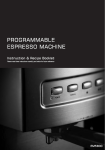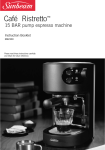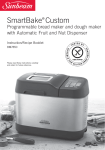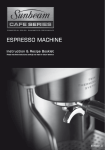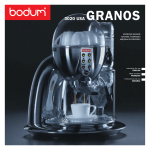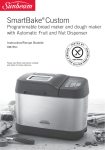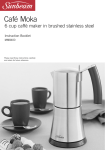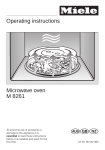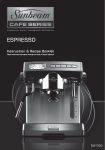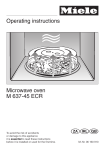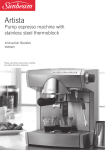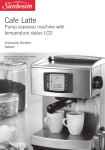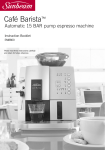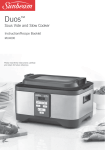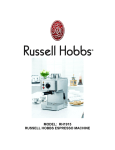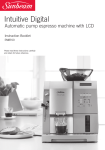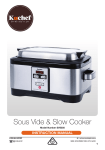Download Sunbeam EM8900 User's Manual
Transcript
Waiting on Front Cover from Energi Contents Sunbeam's Safety Precautions 2 About espresso coffee 3 Features of your Café Series™ Twin Thermoblock Espresso Machine 4 Functions of your Café Series™ Twin Thermoblock Espresso Machine 6 Using the control panel 8 Reference guide to using your espresso machine 11 Programming your espresso machine 18 Preparing your espresso machine before use 20 Guide to the perfect espresso 21 Guide to milk texturing 23 Using the hot water dispenser 24 Espresso recipes 25 Care and cleaning 27 Cleaning the group head 28 Descaling 30 Important instructions – retain for future use. Sunbeam’s Safety Precautions SAFETY PRECAUTIONS FOR YOUR SUNBEAM therefore avoid any direct contact with the ESPRESSO MACHINE steam wand or hot water tap. • Always place the unit on a flat, level surface. • Always disconnect the plug from the power outlet prior to cleaning the espresso machine • Do not operate without water in reservoir. or if there is any problem during the coffee Fill reservoir with only clean and cold water. making process. Observe the maximum filling volume is 3 litres. • Do not allow the power cord to come into • Do not remove the filter handle during the contact with the hot parts of the espresso espresso pour or water flow as the unit is machine, including the cup warming plate, hot under pressure. Removing the filter handle water tap and steam wand. during either of these operations can lead to a • Do not place hands directly under the steam, scalding or injury. hot water or coffee pour as this can lead to a • The steam wand and hot water tap become scalding or injury. very hot during texturing milk and water flow. This may cause burns in case of contact, • • • • • • • • Sunbeam are very safety conscious when designing and manufacturing consumer products, but it is essential that the product user also exercise care when using an electrical appliance. Listed below are precautions which are essential for the safe use of an electrical appliance: Read carefully and save all the instructions provided with an appliance. Always turn the power off at the power outlet before you insert or remove a plug. Remove by grasping the plug - do not pull on the cord. Turn the power off and remove the plug when the appliance is not in use and before cleaning. Do not use your appliance with an extension cord unless this cord has been checked and tested by a qualified technician or service person. Always use your appliance from a power outlet of the voltage (A.C. only) marked on the appliance. Close supervision is necessary when your appliance is being used near children or infirm persons. Never leave an appliance unattended while in use. Young children should be supervised to ensure that they do not play with the appliance. • Do not use an appliance for any purpose other than its intended use. • Do not place an appliance on or near a hot gas flame, electric element or on a heated oven. Do not place on top of any other appliance. • Do not let the power cord of an appliance hang over the edge of a table or bench top or touch any hot surface. • For safety reasons and to avoid maintenance by unskilled persons, some appliances are ‘sealed’ using tamperproof screws. Such appliances should always be returned to the nearest Sunbeam Appointed Service Centre for adjustment or repair if required. • Do not operate any electrical appliance with a damaged cord or after the appliance has been dropped or damaged in any manner. If damage is suspected, return the appliance to the nearest Sunbeam Appointed Service Centre for examination, repair or adjustment. • For additional protection, Sunbeam recommend the use of a residual current device (RCD) with a tripping current not exceeding 30mA in the electrical circuit supplying power to your appliances. • Do not immerse the appliance in water or any other liquid unless recommended. If you have any concerns regarding the performance and use of your appliance, please visit www.sunbeam.com.au or contact the Sunbeam Consumer Service Line. Ensure the above safety precautions are understood. 2 About espresso coffee Congratulations on the purchase of your Sunbeam Café Series™ Twin Thermoblock Espresso Machine. The Sunbeam Café Series™ delivers quality, style and superior performance capturing the essence of the commercial kitchen. Inspired by heavy-duty equipment found in restaurants, cafés and bars, the Sunbeam Café Series™ is built to last. It brings together a range of appliances designed to expertly create authentic café food and beverages at home. Uncompromising blends of stainless steel, brass and die-cast alloy characterise the range. This combined with advanced technology and functional design, guarantee the performance, that each product will surpass expectations. The Sunbeam Café Series™ Twin Thermoblock Espresso Machine features a twin pump, twin thermoblock, TPTT™ system to ensure a stable water temperature while also allowing simultaneous production of espresso and steam to texture milk. The dedicated twin thermoblock heating system takes away the waiting time for water temperatures to adjust between pouring espresso and producing steam. The twin pumps provide the necessary pressure and as a result the coffee maker has access to instant steam for texturing milk and at the same time produce a serve of espresso just like a commercial machine. Another feature of the espresso machine is the pre-infusion. The pre-infusion gradually releases water pressure pre-soaking the coffee grinds before full water pressure is applied. This in turn delivers greater body and sweetness to the espresso. The Café Series™ Twin Thermoblock Espresso Machine is designed with quality die-cast metal components and includes many features that make producing delicious coffee at home even easier. We hope you enjoy your new espresso machine and should you need any further assistance please don’t hesitate to contact the Sunbeam Coffee Hotline on Free Call 1800 025 059. 3 Features of your Café Series™ Twin Thermoblock Espresso Machine Warming plate The large warming plate effectively prewarms cups helping to retain the essential characteristics true of espresso - sweet, creamy taste and aroma. Variable steam control dial Steam wand A dedicated thermoblock and pump provide an instant supply of powerful dry steam for achieving silky, dense and rich milk. The commercial 360° ball joint allows the steam wand to be moved into the ideal position. Commercial size group head Commercial size filter handle Espresso gauge The gauge indicates the quality of the espresso pour. Removable drip tray and grill The large capacity die-cast metal drip tray is lined with plastic, preventing staining from espresso oils, lightweight for easy removal and designed with no dirt traps for simple wipe down cleaning. Height adjustable rubber feet The height adjustable feet ensure the espresso machine is level on the benchtop. Additionally integrated into the two back feet are rollers, these allow the user to effortlessly move the machine – great when trying to clean underneath. 4 Programmable control panel An easy to use control panel provides the choice of manual operation or utilising the programmed espresso pour lengths. Hot water control dial Hot water wand Dispenses a constant and controlled flow of hot water. For ease of use the wand has a commercial 360° ball joint. 3 litre water reservoir Removable 3 litre water reservoir with hand grips for easy filling. Low water warning indicator Accessories All the essential accessories to make an authentic café-quality espresso – 800ml stainless steel milk texturing jug, barista coffee tamp and spoon for measuring out coffee. Measuring spoon 1 Cup filter 800ml jug 2 Cup filter Tamp 5 Functions of your Café Series™ Twin Thermoblock Espresso Machine Twin Pump and Twin Thermoblock – TPTT™ System Italian designed and manufactured, the machine is fitted with a 15 BAR pump for the espresso function, delivering the pressure required for a complete extraction of oils, coffee solids and aroma. An additional 4 BAR pump is dedicated to the steam function, producing instant steam pressure for texturing milk. TPTT™ System – Simultaneous Use True to commercial use, the unique TPTT™ System features twin pumps and twin thermoblocks, this allows the coffee maker to texture milk and pour an espresso simultaneously. Independent thermoblock heating systems lined with stainless steel and brass, heat the water ensuring the precise temperature is achieved for each function eliminating waiting time and reducing temperature fluctuations. Espresso Gauge The gauge indicates the quality of the espresso pour. Whilst the needle is within the target area on the gauge the coffee maker knows that they have made an excellent serve of espresso. Should the needle fall below the target area then it’s an indication to the coffee maker that the serve of espresso is under extracted. Excellent Pour Under Extracted Pour 6 Over Extracted Pour Functions of your Café Series™ Twin Thermoblock Espresso Machine continued Should the needle go beyond the target area then it’s an indication to the coffee maker that the serve of espresso is over extracted. To achieve an excellent pour of liquid espresso a combination of a fine espresso grind and the correct amount of coffee packed firmly and evenly in the filter will help attain this result. Control Panel An easy to use control panel provides the choice of manual operation or utilising the programmed espresso pour lengths. The programmed espresso pour is set to 35mls per cup while the program function allows users to personalise and save their own espresso settings. Tip: Achieving a good pour of liquid espresso is more likely when using freshly ground coffee beans. Commercial Size Group Head & Filter Handle The group head, filter handle and filters are designed to commercial specifications using brass and stainless steel components. These elements help contribute to the preparation of an espresso serve, as it allows the coffee maker to pack the necessary amount of coffee grinds, which then expand firmly and evenly onto the shower screen. Pre-Infusion Pre-infusion is programmed into the ‘MANUAL’, single espresso and double espresso operations. It is a gradual release of water pressure pre-soaking the coffee cake before full water pressure is applied. This in turn delivers greater body and sweetness to the espresso. Anti Calc Filter An Anti Calc water filter reduces impurities that taint the flavour and odour of the water, improving the taste and aroma of the espresso brewed. Additionally, scale build up is slowed reducing the frequency of cleaning required. The Anti Calc water filter fitted inside the 3 litre water reservoir has a 12 month life for domestic use and a 3 month life for commercial use. Note: Contact Sunbeam on 1800 025 059 for replacement filters. 7 Using the control panel Power Press the ‘POWER’ button once to turn the espresso machine on. The light above the ‘POWER’ button will illuminate green and start flashing; this is to indicate that your espresso machine is on and is heating up. Note: Before turning on the espresso machine ensure that the steam and hot water control dials are in the OFF position. When the green light above the ‘POWER’ button stops flashing and turns to a constant red light, this indicates that the espresso machine is heated and ready to use. The lights above the ‘MANUAL’, single and double espresso buttons will also show a constant green light. To turn the espresso machine off, simply press the ‘POWER’ button, the red power light and all other lights on the control panel will turn off. Manual The ‘MANUAL’ button allows the coffee maker to have complete control over the length of the espresso pour. Once the espresso machine is switched on and heated, so the light above the ‘POWER’ button is red and the lights above the ‘MANUAL’, single and double espresso buttons show a constant green light, the coffee maker is able to use the manual 8 operation. The coffee maker simply needs to press to the ‘MANUAL’ button once to start the pour and again to stop. Important: Once the manual operation is activated, before the espresso pour starts the pre-infusion feature will release three short bursts of gradual water pressure onto the coffee cake. After this the full water pressure is applied and the espresso will pour freely. Note: When the coffee maker has activated the manual operation the lights above the single and double espresso buttons will go off. The lights above the ‘POWER’ and ‘MANUAL’ buttons will remain on. Single Espresso The single espresso function removes the guesswork and is programmed to pour 35mls of liquid espresso. Tip: We recommend using the single cup filter when using the programmed single espresso operation. Once the espresso machine is switched on and heated, so the light above the ‘POWER’ button is red and the lights above the ‘MANUAL’, single and double espresso buttons show a constant green light, the coffee maker is able to use the single espresso operation. The coffee maker simply needs to press the single espresso button once to start and the pour of liquid espresso will stop automatically. Important: Once the single espresso operation is activated, before the espresso pour starts the pre-infusion feature will release three short bursts of gradual water Using the control panel continued pressure onto the coffee cake. After this the full water pressure is applied and the espresso will pour freely. Note: When the coffee maker has activated the single espresso operation the lights above the ‘MANUAL’ and double espresso buttons will go off. The lights above the ‘POWER’ and single espresso buttons will remain on. Note: The coffee maker does not need to press the single espresso button again to end the pour as the espresso machine will stop automatically. button once to start and the pour of liquid espresso will stop automatically. double espresso Important: Once the operation is activated, before the espresso pour starts the pre-infusion feature will release three short bursts of gradual water pressure onto the coffee cake. After this the full water pressure is applied and the espresso will pour freely. Note: When the coffee maker has activated the double espresso operation the lights above the ‘MANUAL’ and single espresso buttons will go off. The lights above the ‘POWER’ and double espresso buttons will remain on. Once the pour of liquid espresso stops the espresso machine is ready to make another espresso. Note: When using the single espresso operation you can stop the pour of espresso at any time by pressing the ‘MANUAL’, single, or double espresso operation buttons. Double Espresso The double espresso function removes the guesswork and is programmed to pour 70mls of liquid espresso. Tip: We recommend using the double cup filter when using the programmed double espresso operation. Once the espresso machine is switched on and heated, so the light above the ‘POWER’ button is red and the lights above the ‘MANUAL’, single and double espresso buttons show a constant green light, the coffee maker is able to use the double espresso operation. The coffee maker simply needs to press the double espresso Note: The coffee maker does not need to press the double espresso button again to end the pour as the espresso machine will stop automatically. Once the pour of liquid espresso stops the espresso machine is ready to make another espresso. Note: When using the double espresso operation you can stop the pour of espresso at any time by pressing the ‘MANUAL’, single, or double espresso operation buttons. Program The program function allows the coffee maker to personalise and save their own espresso pour settings. Note: Refer to the section ‘Programming your espresso machine’ for simple to follow instructions. 9 Heading Using the control panel continued Once the espresso machine is switched on and heated, so the light above the ‘POWER’ button is red and the lights above the ‘MANUAL’, single and double espresso buttons show a constant green light, the coffee maker is able to use the program function. To activate the program function, the coffee maker simply needs to press ‘PROGRAM’ button. 10 Note: When the coffee maker has activated the program function the light above the ‘PROGRAM’ button will show a constant red light and the light above the ‘MANUAL’ button will go off. Additionally the lights above the ‘POWER’, single and double espresso buttons will remain on. Heading Reference guide to using your espresso machine The diagrams below and on the following pages are to assist you in operating your Café Series™ Twin Thermoblock Espresso Machine. Throughout the instruction booklet reference will be made to these diagrams, so each of them has been numbered for convenience and ease of use. For example: Fill the water reservoir (1) (2) (3) (4) (5) with cold tap water….. Each time you see these numbers please refer back to these diagrams. Preparing the espresso machine 1 Open lid of water reservoir. 4 Remove water reservoir. 2 Fill in place with cold water, OR 3 Open rear door to access reservoir 6 5 Fill at sink with cold water. Press 'POWER' button to turn unit on. 2 cup filter 1 cup filter 7 Control panel lit and ready to use. 8 9 Warming the espresso cups. Select appropriate filter and place into handle. 11 Reference guide to using your espresso machine continued 10 Place filter handle onto group head. 11 Turn filter handle to the right as far as it will go. 12 Place large container under both pouring spouts. Making the espresso 13 Press the 'MANUAL' button and allow the water to run through. 14 Select appropriate filter and place into handle. 16 Place finely ground coffee into filter. 12 15 Hold filter handle under group head and purge with water to preheat. 18 17 Tamp the coffee. Wipe the edge of filter to remove any coffee grinds. Reference guide to using your espresso machine continued 20 19 Place filter handle onto group head. Turn filter handle to the right as far as it will go. 22 Press 'MANUAL' button for a continuous pour. 21 Place glasses/cups below pouring spouts. 23 Press the button for a single serve of espresso. 24 Press the button for a double serve of espresso. Programming 2 cup filter 1 cup filter 25 Remove filter handle by turning to the left. 26 Discard the used coffee grinds. 27 Fit the handle with appropriate filter. 13 Reference guide to using your espresso machine continued 28 Fill with finely ground coffee. Tamp the coffee grinds. 31 Turn filter handle to the right as far as it will go. 30 29 Place filter handle onto group head. 32 Press the 'PROGRAM' button. 33 Press the single espresso button to start and end the pour. Texturing milk 34 Press the double espresso button to start and end the pour. 14 35 Purge the steam wand by turning dial clockwise. 36 Turn off steam by turning dial anti-clockwise. Reference guide to using your espresso machine continued 37 Swing steam wand to the side of espresso machine. 38 39 Place steam wand into milk, approx. 1cm below surface and activate the steam function. Angle jug to rest steam wand on spout and place nozzle just below surface of the milk. 41 42 40 Raise the jug until nozzle is in the centre of milk. Close the steam by turning dial anti-clockwise. Wipe steam nozzle and wand with damp cloth. Hot water 44 43 Place cup under hot water nozzle and activate the hot water function. Close the hot water by turning dial clockwise. 45 Swing hot water wand over the drip tray. 15 Heading Reference guide to using your espresso machine continued Cleaning 46 Remove the grill. 48 47 Remove drip tray. Wrap steam wand with damp cloth and turn steam on for 10 seconds. 2 cup filter basket 49 Insert cleaning pin into the hole, at base of steam nozzle. 50 Remove cleaning disc from inside the rear door. 52 Position cleaning disc inside the 2 cup filter. 16 51 Fit handle with the 2 cup filter. 53 Place cleaning tablet into filter basket with cleaning disc. 54 Place filter handle onto group head. Reference guide to using your espresso machine continued 55 Turn filter handle to the right as far as it will go. 56 Place large container under both pouring spouts. 57 Remove filter handle from the group head. 17 Programming Heading your espresso machine The Café Series™ Twin Thermoblock Espresso Machine has programming capabilities. Based on café settings the single and double espresso functions are set at 35 and 70mls. However by following a few simple steps the coffee maker can personalise the espresso machine to achieve a serve of espresso to exactly how they like it. Programming Single Espresso 1. Prepare the filter handle. Fit the filter handle with the one cup filter basket (27) and fill with finely ground coffee (28). Using the coffee tamp supplied, tamp the coffee grinds (29). Secure the filter handle to the group head (30)(31). 2. Place a cup under both pouring spouts. 3. To commence programming press the ‘PROGRAM’ button (32). The light above the ‘PROGRAM’ button will show a constant red light and the light above the ‘MANUAL’ button will go off. Additionally the lights above the ‘POWER’, single and double espresso buttons will remain on. 4. Press the single espresso button once to start the espresso pour (33). The light above the double espresso button will go off and only the ‘POWER’, single espresso and ‘PROGRAM’ lights will remain on. 5. Allow the espresso to pour until the desired level. Once the desired level is reached stop the espresso pour by pressing the single espresso button. 2 beeps will signify that the new setting for the single espresso operation has been programmed and stored into the machines memory. 6. The espresso machine will then return to normal operation mode and is ready to make another espresso at the push of a button. 18 Programming Double Espresso 1. Prepare the filter handle. Fit the filter handle with the two cup filter basket (27) and fill with finely ground coffee (28). Using the coffee tamp supplied, tamp the coffee grinds (29). Secure the filter handle to the group head (30)(31). 2. Place two cups under each pouring spout. 3. To commence programming press the ‘PROGRAM’ button (32). The light above the ‘PROGRAM’ button will show a constant red light and the light above the ‘MANUAL’ button will go off. Additionally the lights above the ‘POWER’, single and double espresso buttons will remain on. 4. Press the double espresso button once to start the espresso pour (34). The light above the single espresso button will go off and only the ‘POWER’, double espresso and ‘PROGRAM’ lights will remain on. 5. Allow the espresso to pour until the desired level. Once the desired level is reached stop the espresso pour by pressing the double espresso button. 2 beeps will signify that the new setting for the double espresso operation has been programmed and stored into the machines memory. 6. The espresso machine will then return to normal operation mode and is ready to make another espresso at the push of a button. Resetting the Factory Settings To revert back to the original factory settings; 1. Insert the power cord into a 230-240V AC power outlet and switch the power ‘ON’. Programming your espresso machine continued Heading Important: Although the espresso machine is on at the power outlet ensure that the actual espresso machine power is ‘OFF’. Therefore no lights will be illuminated on the espresso machine control panel. 2. Press and hold down the ‘MANUAL’ button. While still holding down the manual button briefly press the ‘POWER’ button and then release the ‘MANUAL’ button. 3. When you hear the 4 beeps and the power light flash the espresso machine will have returned to the original factory settings and the next time the single or double espresso functions are used the espresso pours will be 35 and 70mls. 19 Preparing Heading your espresso machine before use 1. Place the espresso machine onto a dry, stable benchtop. 2. Ensure the drip tray and grill are in place. 3. Fill the espresso machine with water. There are a couple of ways in which the water reservoir can be filled; a) Simply lift the lid of the water reservoir at the top of the espresso machine (1) and using a jug, fill with fresh cold water or filtered water (2). b) Alternatively the water reservoir can be removed and filled with fresh cold water. To do so, open the door on the back of the espresso machine (3) and simply slide out the water reservoir (4). Then fill with fresh cold water or filtered water (5). Replace the water reservoir firmly and shut the door. 4. Insert the power cord into a 230-240V AC power outlet and switch the power on. Press the ‘POWER’ button once to turn the espresso machine on (6). The light above the ‘POWER’ button will illuminate green and start flashing, this is to indicate that your espresso machine is on and is heating up. When the green light above the ‘POWER’ button stops flashing and turns to a constant red light, this indicates that the espresso machine is heated and ready to use. The lights above the ‘MANUAL’, single and double espresso buttons will also show a constant green light (7). 20 Note: Before turning on the espresso machine ensure that the steam and hot water control dials are in the OFF position. 5. Place glasses and cups on the warming plate (8). Important: For first time use or if the machine has not been used for some time, it is important that the machine is rinsed as follows: 6. Fit the filter handle with the either the one or two cup filter basket (9). Secure the filter handle to the group head (10) (11). 7. Place a sufficiently large container under both pouring spouts (12). 8. Once the espresso machine is switched on and heated, so the light above the ‘POWER’ button is red and the lights above the ‘MANUAL’, single and double espresso buttons show a constant green light, the espresso machine is heated and ready to use. Tip: Remember if the ‘POWER’ light is flashing green, this indicates that the espresso machine is on and is heating up. 9. Press the ‘MANUAL’ button (13) and allow the water to run through until the water reservoir is empty. Note: As a safety mechanism the espresso machine is programmed to automatically stop the water flow after 240mls, therefore you will need to press the ‘MANUAL’ button again to restart the water flow. Heading Guide to the perfect espresso Preheat Glasses 1. Preheat the glasses/cups by filling them with hot water as this will assist to preserve the crema of the espresso. Set the glasses/ cups aside. Preheat Filter Handle and Filter Basket 2. Select the appropriate filter basket and place it into filter handle (14). Tip: Use the one cup filter basket for a single serve of espresso and the two cup filter basket for a double serve of espresso. and this will vary depending on the bean. For example to achieve a slower espresso pour rate use a finer grind and a coarser grind for a faster espresso pour rate. Tip: Ensure the coffee tamp is dry because if it is wet the coffee grinds will stick to it. The Espresso Pour 8. Lock the filter handle onto the group head (19)(20). 9. Empty the glasses/cups and place below the pouring spouts (21). 3. Take the filter handle, hold it under the group head and purge water. With the filter basket positioned under the group head press the ‘MANUAL’ button to start the water flow and press it again to stop (15). Note: Check to see that the espresso machine is ready for use, remember that if the ‘POWER’ light is flashing green, this indicates that the espresso machine is on and is heating up. 4. Dry the filter basket. 10. Press the required volume button; ‘MANUAL’ for a continuous pour (22), the single espresso for a 35ml pour (23) or the double espresso for a 70ml pour (24). Dosing and Tamping 5. Using the measuring spoon supplied, place finely ground coffee into the filter basket (16). 6. Rest the filter handle with the filter basket in position onto the benchtop. Take the coffee tamp, apply firm level packing pressure (17), twisting 90 degrees to polish the grounds. This seals the surface of the coffee cake. 7. Brush any excess coffee grounds from around the edge of the filter basket (18). Important: Be sure not to over dose the filter basket with coffee. As a guide the top of the stainless steel section on the base of the coffee tamp needs to be level with the top rim of the filter basket. Tip: The coffee dosage and the degree of tamping should remain the same every time you make a coffee the only thing that should vary is the coarseness of the coffee grounds Note: When using the ‘MANUAL’ operation the coffee maker must press the button once to start the pour and again to stop the pour. However with the single and double espresso operations the coffee maker need only to press these buttons once to start the espresso pour and the program will automatically stop the pour at the preprogrammed level. Pre-Infusion 11. Once an espresso operation has been activated, before the espresso pour starts the pre-infusion feature will release three short bursts of gradual water pressure onto the coffee cake. After this, the full water pressure is applied to the coffee cake and the espresso will pour freely. 21 Heading Guide to the perfect espresso continued 12. Check the espresso pour. The ideal pour is dark and caramel with reddish reflections. The pour should hang vertically on each spout and resist like dripping honey. Tip: Refer to the espresso gauge on the espresso machine as this will help indicate the quality of the pour. 13. Serve espresso immediately. Caring for your Espresso Machine 14. Remove the filter handle from the group head (25). 15. Discard the used coffee grinds from the filter basket (26). 22 Tip: After each use of the espresso machine we recommend that a small amount of water is cycled through the group head as this will wash out any old or used coffee grinds stuck to the underside of the group head. Simply press the ‘MANUAL’ button and allow some water to run through. Sleep Mode After 1 hour of non-use the espresso machine will automatically switch to ‘SLEEP MODE’. An indication that the machine is in ‘SLEEP MODE’ is the light above the ‘POWER’ button will slowly flash red. After a further 26 hours of non-use the espresso machine will turn off. Heading Guide to milk texturing Milk texturing is the steaming of milk. The steam does two things, firstly it heats the milk and secondly the steam mixes air with the milk to form an ‘emulsion’ of tiny bubbles that gives a silky velvet texture. Similar to making an espresso, perfecting the art of milk texturing takes time and practice. Tip: Remember espresso is the foundation for all café style drinks and the milk is the variable. 1. Determine how much milk is needed based on the number of cups being made or the size of the texturing jug. Tip: Keep in mind that the volume of milk will increase or ’stretch’ during the texturing. 2. Pour cold refrigerated milk into a stainless steel jug, between ½ to ²/³ full. Tip: Store the stainless steel jug in the fridge so that it is well chilled. Also be sure not to rinse the jug with warm water before use. 3. Purge the steam wand of any water. With the steam wand positioned over the drip tray activate the steam function by turning the steam control dial clockwise as far as it will go (35). Once any water has been purged close the steam by turning the steam control dial anticlockwise (36). 4. Swing the steam wand to the side of the espresso machine (37). 5. Place the steam wand into the milk so that the nozzle is about a centimetre below the surface and activate the steam function by turning the steam control dial clockwise as far as it will go (38). 6. Angle the jug so that the steam wand is resting on the spout of the jug and lower the jug until the tip of the steam nozzle is just below the surface of the milk. This will start to create a whirlpool action in the milk (39). Note: Do not allow the steam to spurt unevenly or it will create aerated froth/large bubbles. If this is happening raise the jug so that the steam nozzle is lowered deeper into the milk. Remember the ideal consistency is a silky velvet texture. 7. As the steam heats and textures the milk, the level of the milk in the jug will begin to rise. As this happens follow the level of the milk by lowering the jug, always keeping the tip of the steam nozzle just below the surface. 8. Once the foam is created raise the jug until the steam nozzle is in the centre of the milk (40). Tip: The amount of foam required will vary depending on the drinks being made, for example a cappuccino requires more foam than a flat white. 9. Close the steam immediately when the milk is heated to between 60-65°C by turning the steam control dial anticlockwise (41). Tip: If you don’t have a thermometer a good indication that the correct temperature has been reached is when you are unable to leave the palm of your hand against the side of the jug for more than 3 seconds. Important: Do not boil the milk. 10. Remove the jug and wipe the steam nozzle and wand with a clean damp cloth (42). 11. With the jug in hand tap the jug on the bench top to release the trapped air bubbles and then swirl the jug in a circular motion until the milk becomes shiny and no bubbles remain, this helps the milk and froth combine for an even consistency. By swirling the milk you can see the foam in the jug swirling with your movement this will enable you to judge the thickness of your foam. 23 Using Heading the hot water dispenser The hot water dispenser is ideal for preparing long blacks, hot chocolate and filling coffee plungers and tea pots. 1. Swing the hot water wand to the side of the espresso machine. 2. Place the cup or container under the hot water nozzle and activate the hot water function by turning the hot water control dial anti-clockwise as far as it will go (43). 24 3. Once you have dispensed the required amount of hot water into the cup or container, close the hot water by turning the hot water control dial clockwise (44). 4. Remove the cup or container and swing the hot water wand over the drip tray to catch any drips of water (45). Espresso recipes ESPRESSO (SHORT BLACK) MACCHIATO Espresso is a concentrated, full bodied coffee with a stable layer of cream on top – known as ‘crema’. An espresso is the foundation of all café coffee. Variations are achieved by adding different amounts of milk and froth. Macchiato, Italian for ‘to stain or mark’. Traditionally served as a standard espresso with a dash of milk and a small dollop of froth into the middle of the ‘crema’. • 90mL espresso glass or demitasse cup • single or double espresso • single espresso (30-35mL) • marked with steamed milk froth LONG BLACK FLAT WHITE A standard espresso with hot water, served in a regular coffee cup or mug. The hot water is added first so that the ‘crema’ is maintained. Another old favourite, the Flat White is an espresso with steamed milk, served in a regular coffee cup or mug. The layer of frothed milk on top should be 2mm to seal the coffee. • 190mL cup • hot water (to taste) • single or double espresso • 90mL espresso glass or demitasse cup • 190mL cup • single or double espresso • steamed milk 25 Espresso recipes continued CAFFE LATTE CAFFE MOCHA An espresso with steamed milk, typically served in a glass. The layer of frothed milk on top should be 10mm to seal the coffee. • 220mL glass or cup Made in a similar way to a cappuccino but with the addition of drinking chocolate. Simply stir the chocolate into the espresso prior to adding the steamed milk and froth. • single or double espresso • 190-240mL cup or tall glass • steamed milk • single or double espresso • two teaspoons of drinking chocolate • two-thirds milky coffee, one-third froth CAPPUCCINO CON PANNA This delicious drink is an espresso with steamed milk, topped with creamy froth and a dusting of chocolate. The resulting drink is approximately two-thirds milky coffee, onethird froth. A variation on the original Vienna coffee, this delicious drink is made up of an espresso topped with lightly whipped cream. It can also be dusted with cinnamon or drinking chocolate. • 190-240mL cup • 190mL cup • single or double espresso • single or double espresso • two-thirds milky coffee, one-third froth • lightly whipped cream • dusted with chocolate • dusted with cinnamon or chocolate 26 Care and cleaning The coffee making process involves extracting oils out of coffee grinds to make espresso coffee. Deposits of these oils build up over time and affect the taste of the coffee and operation of the espresso machine. Group head rubber seal The group head seal is located on the underside of the group head and creates a seal against the filter handle during the espresso pour. Regular cleaning to remove these oils is essential and will maintain the quality of the coffee the espresso machine produces and result in less maintenance being required. This is easy to do by following a few quick and easy cleaning steps after each coffee making session; Note: During long periods of non-use we recommend that the filter handle not be left attached to the group head as this will reduce the life of the seal. Cycle water through the group head, Purge steam through the steam wand, Wipe the steam wand clean with a damp cloth immediately after use, Over time the seal will loose its elasticity and require replacement, depending on use usually every 12 months. Signs that the seal is deteriorating are when the filter handle cannot create the necessary seal and steam escapes from around the group head during the espresso pour. Remove the filter basket from the filter handle and clean away any old coffee oils, and Note: Contact Sunbeam on 1800 025 059 should you think that the group head seal needs replacing. Empty the drip tray and rinse. Cup warming plate, hot water wand and exterior Wipe over the unit with a damp cloth and wipe dry. Do not use abrasives or metal scourers as these will scratch the exterior surface. Important: Never wash any of the espresso machine parts or accessories in the dishwasher. Drip tray and grill Remove the grill and drip tray at regular intervals to empty (46) (47). Clean with water and a little non-abrasive washing up liquid, rinse and dry. Group head, filter handle & filter baskets The filter baskets and filter handle should be rinsed with warm water after each use and then dried thoroughly. To clean the group head of any old coffee grinds cycle water through and wipe the group head and around the inside rim with a damp cloth. Should the holes in the filter baskets become clogged with coffee granules use a fine bristled brush to remove them. Steam wand Keeping the steam arm clean is essential to ensure maximum efficiency of the steam function. A build up of caramelised/dried milk on the steam wand will impair the steaming and texturing ability of the espresso machine. Important: Wipe the steam wand clean with a damp cloth immediately after each use and purge a small amount of steam. Should the milk dry/caramelise on the steam wand, simply wrap the wand with a clean damp cloth, turn the steam wand over the drip tray and turn the steam on for approximately 10 seconds (48). With the cloth still on the steam wand leave to soak 27 Care and cleaning continued for about 5 minutes and you will find that after this time the dry/caramelised milk will easily wipe away. Repeat process if still dirty. Important: Never clean the steam wand with an abrasive pad as this will damage the steam wand. Should the steam wand become blocked, supplied with the espresso machine is a cleaning pin. The cleaning pin is located on the inside of the back door of the espresso machine. With the cleaning pin insert it into the hole in the base of the steam nozzle (49). Should the steam wand remain blocked unscrew the steam nozzle from the steam wand. Clean the steam nozzle by once again using the cleaning pin then flush under running water. Cleaning the group head Deposits of coffee oils build up over time and affect the taste of the coffee and operation of the espresso machine. Therefore the group head will require regular cleaning. It is recommended that the group head is cleaned every 3 months, this will vary depending on the frequency of use. 4. Empty and rinse clean the drip tray, then place back into position on to the machine. Preparing for the cleaning cycle 1. Remove the water reservoir and rinse clean. To do so, open the door on the back of the espresso machine (3) and simply slide out the water reservoir (4). With fresh water completely fill (5) and replace the reservoir. 7. Place a Sunbeam Espresso Machine Cleaning Tablet into the filter basket that is now also fitted with the cleaning disc (53) and secure the filter handle to the group head (54) (55). 2. With the door to the back of the espresso machine still open remove the cleaning disc, located on the inside of the back door (50). 3. Should the filter handle be attached to the group head remove it. Remove the filter basket and rinse both thoroughly under running water and set aside. 28 5. Fit the filter handle with the two cup filter basket (51). 6. Position the cleaning disc into the two cup filter basket (52). 8. Place a sufficiently large container under both pouring spouts (56). Starting the cleaning cycle 9. Insert the power cord into a 230-240V AC power outlet and switch the power ‘ON’. Note: Although the espresso machine is on at the power outlet ensure that the actual espresso machine power is ‘OFF’. Therefore Cleaning the group head continued no lights will be illuminated on the espresso machine control panel. 10. Simultaneously press and hold down double espresso the single and buttons. While still holding down the single and double espresso buttons briefly press the ‘POWER’ button. As the lights on the control panel start to chase from left to right release the single and double espresso buttons. Note: The lights on the control panel will continue to chase until the cleaning cycle is completed, this will take approximately 10 minutes. Note: During the cleaning cycle all other espresso machine operations will be locked until the cleaning cycle is completed. Should the cleaning cycle be accidentally started it can be cancelled by switching the power ‘OFF’ at the power outlet. 11. When the cleaning cycle is completed the lights on the control panel will stop chasing and the espresso machine will beep 4 times. Following this, the lights above the 'POWER', 'MANUAL', single and double espresso buttons will come on, signalling that the machine is ready to use. 12. Remove the container from under the pouring spouts and empty. 13. Remove the filter handle from the group head (57). 14. Remove the cleaning disc from the filter handle and return to storage position on the inside of the back door. 15. Remove the two cup filter basket from the filter handle and wash in warm soapy water. Rinse well and dry. 16. The espresso machine is now ready for use. 29 Descaling Scale is a surface build up of minerals that naturally occur over time in all appliances that are involved with the heating of water. Therefore the espresso machine will require occasional descaling. It is recommended that the espresso machine is decaled every 4-6 months, this will vary depending on the frequency of use. 2. Should the filter handle be attached to the group head remove it, rinse thoroughly under running water and set aside. Descaling solution Use any of the following when descaling the espresso machine: Important: Be careful not to lose the filter/screen and screw once you have disassembled the group head. Sunbeam Espresso Machine Descaling Tablets 5. Place a sufficiently large container under the group head. Sunbeam Liquid Descaler, or 6. Insert the power cord into a 230-240V AC power outlet and switch the power ‘ON’. Press the ‘POWER’ button once to turn the espresso machine on. Vinegar Solution. Descaling the espresso machine Note: Ensure the espresso machine is turned off and the power cord is unplugged. 1. Remove the water reservoir and rinse clean. Depending on the descaling solution being used use one of the following: A. Sunbeam Espresso Machine Descaling Tablets Fill the water reservoir with 1 litre of warm water and place a descaling tablet into the reservoir. Once the tablet has dissolved replace the reservoir, this takes about 5-7 minutes. B. Sunbeam Liquid Descaler Fill the water reservoir with approximately 1.5 litres of water, add 1 capful of Sunbeam Liquid Descaler and replace the reservoir. C. Vinegar solution Fill the water reservoir with approximately 1.5 litres of warm water, add 3 tablespoons of vinegar and replace the reservoir. 30 3. Using a screwdriver unscrew the brewing filter/shower screen from the underside of the group head. 4. Remove and set aside the filter/screen and screw in a safe place. Note: Remember if the ‘POWER’ light is flashing green this indicates that the espresso machine is on and is heating up. When the green light above the ‘POWER’ button stops flashing and turns to a constant red light this indicates that the espresso machine is heated and ready to use. Additionally the lights above the ‘MANUAL’, single and double espresso buttons will show a constant green light. 7. Press the ‘MANUAL’ button and allow half the solution to cycle through the group head and then once again press the ‘MANUAL’ button to stop the flow. Important: Do not run descaling solution through the steam wand. Note: As a safety mechanism the espresso machine is programmed to automatically stop the water flow after 240mls, therefore you will need to press the ‘MANUAL’ button again to restart the water flow. Descaling continued Note: Depending on the size of the container under the group head on occasion this may need to be emptied throughout this process. 13. Press the ‘MANUAL’ button and allow the entire water reservoir to cycle through the group head. 8. After half the solution has cycled through press the ‘MANUAL’ button to stop the flow and then press the ‘POWER’ button to turn the machine off. Note: As a safety mechanism the espresso machine is programmed to automatically stop the water flow after 240mls, therefore you will need to press the ‘MANUAL’ button again to restart the water flow. 9. Leave the machine off for 10-15 minutes to allow the descaler solution to take affect. 10. Press the ‘POWER’ button once to turn the espresso machine on. 11. Press the ‘MANUAL’ button and allow the remaining solution to cycle through the group head. 12. Remove the water reservoir from the machine and rinse thoroughly under running water, ensuring that all traces of the descaling solution is removed. Fill with clean water and replace the reservoir. Note: Depending on the size of the container under the group head on occasion this may need to be emptied throughout this process. 14. When this is finished remove the container under the group head and give the machine a good wipe over. 15. Carefully replace the brewing filter/shower screen to the group head. Important: Ensure the screw is tightened well. 16. Fill the water reservoir with fresh water and position it on to the machine. 31 ‘Sunbeam’, is a registered trademark of Sunbeam Corporation. ‘Café Series’ is a trademark of Sunbeam Corporation. Made in China. Due to minor changes in design or otherwise, the product may differ from the one shown in this leaflet. Backed by Sunbeam's 12 Month Replacement Guarantee and National Service Network. © Copyright. SUNBEAM CORPORATION LIMITED 2005. (INCORPORATED IN N.S.W.) A.C.N. 000 006 771 Sunbeam Corporation is a division of GUD Holdings Ltd. For more information or advice on this or any other Sunbeam appliance, visit www.sunbeam.com.au or contact the Sunbeam Consumer Service Line. Australia 1800 025 059 New Zealand 0800 786 232. Consumer Hotline Australia 1800 025 059 New Zealand 0800 786 232 www.sunbeam.com.au Sunbeam ‘Cafe Series’ logo and words ‘Cafe Series’ are trademarks of Sunbeam Corporation. ACN 000 006 771. © Sunbeam Corporation Limited 2005.


































